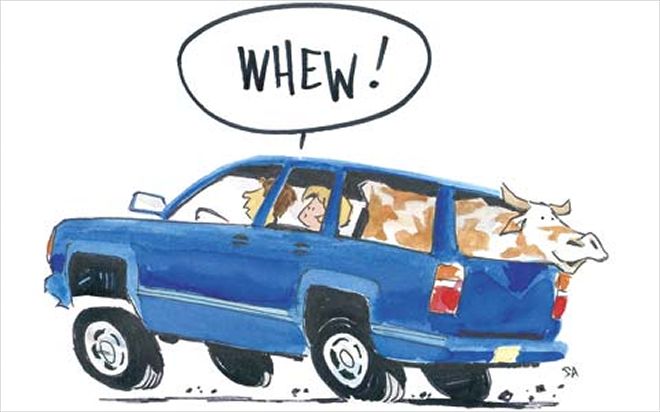Tracking Down the SmellQ: I have a 1999 Suburban, and my wife noticed that the cargo area's carpet is wet. I'm not sure if it's leaking around the gasket on the door or if it's coming from the rear A/C. Is there a rear heater core? The moisture is starting to create slime and a bad smell.
A: The auxiliary heat/air-conditioning system incorporates its own heater core and evaporator in the rear of the vehicle. The coolant and refrigerant hoses are routed from the engine and the A/C compressor up front. And, yes, just like in the front, a plugged-up evaporator drain may cause an overflow of condensation into the truck. On the other hand, similar Suburbans have had problems with rainwater intrusion in the rear compartment. Your local Chevy dealer should have a copy of Technical Service Bulletin Number 00-08-66-001. This TSB gives a detailed procedure for installing a new rear-entry weatherstrip and properly adjusting the rear doors or endgate. This isn't the type of job you want to do twice--never seal anything prior to pulling up the carpet and inspecting for leaks while thoroughly hosing down the vehicle from the outside. Also, let the A/C run to be sure condensation is flowing freely from the evaporator drain to the street. When repairs are complete, always water-test one last time to confirm the fix. Then replace all of the carpet's padding/insulation, thoroughly dry the carpet and floor, and clean and disinfect everything to prevent a recurrence of any mildew odor.
Diesel Fuel EconomyQ :I purchased a 2002 Ford Super Duty F-350 Crew Cab with the 7.3-liter diesel engine and automatic transmission. My family loves this truck for daily use and when we pull our 32-foot Jayco fifth wheel on vacation. The bargaining chip in my purchase was the terrific mileage diesels are supposed to get. This is where we get to my issue: Almost every Super Duty diesel owner I've talked to has reported mileage in the 15-23-mpg range. When it was new, I was getting about 17 mpg and expected it to increase as the motor broke in, but the opposite has happened. My mileage has dropped little by little each time I pull my trailer. I'm now getting 11 mpg on average. I've been to the dealer--where I purchased my truck--multiple times and the diagnostic scanner hasn't shown any fault codes. The dealer blamed everything from the fuel and air filters (replaced), the engine oil used, and the blends of winter/summer fuels, and has implied that everyone I've spoken to hasn't been entirely truthful about the mileage. I don't want to wait until my warranty is up to find out I need a new set of injectors or, worse, that the motor needs to be replaced.
A: The Environmental Protection Agency doesn't require manufacturers to post fuel-economy estimates on trucks above 8500 pounds that are GVW-classified as heavy-duty. This lack of a uniform standard leaves us on our own to figure it out. Hopefully, the technicians evaluating the problem are correct in determining the engine, transmission, and all surrounding systems are in the clear. If it's been the same technician at the same service department each time, take it to another dealership and ask for the shop foreman or a top diagnostician to check it out. Always hold on to the paperwork. If you have the complaint documented while under warranty, you'll have a strong case if the truck is diagnosed later. Fuel-mileage estimates are just that, estimates. There are so many variables that odds are slim for any two vehicles with two different drivers, on two different roadways, to produce exactly the same numbers. Towing, hauling, and high-speed driving are going to considerably affect your fuel efficiency. It sounds like you were referring to fuel economy while towing, so here are a couple of comparative examples. Gale Banks Engineering did some before/after testing on a 2001 F-350 with the Power Stroke 7.3-liter turbodiesel. Before the addition of several performance enhancements, the stock truck averaged 12.89 mpg pulling a 10,000-pound trailer over variable roadways and averaging about 60 mph. (You can log on to www.bankspower.com for more details.) The fuel economy was up to 13.14 mpg after making changes to the intake, exhaust, transmission, and fuel calibration. Our own Truck Trend personnel have come up with an average of about 13.5 mpg on a 2004-model Super Duty one-ton dualie with the 6.0-liter Power Stroke engine and five-speed automatic transmission, pulling an 8000-pound boat (September/October 2004). Unloaded, the same truck on the same route, with the same driver, came in just under 17 mpg.

| 163 0412 Ttg01 Z

| 163 0412 Ttg02 Z
Through the CloudsQ: I have a 2000 F-150 XLT that puffs blue smoke after it's been driven a reasonable distance, about 110-150 miles. This occurs when it sits overnight. Sometimes it comes out in small quantities, but other times my truck spits out a cloud. I've taken it to the dealer three or four times, and they can't seem to duplicate the problem. I've discussed this with independent mechanics, and they're sure it's being caused by defective valve-stem seals. It doesn't do this during everyday driving, and up until recently it didn't use any oil. However, I checked it the other day and the oil level was at the "Add" line. The engine is the 4.6-liter Triton and has 36,000 miles on it. It first started doing this at around 12,000 miles.
A: The Ford 4.6-liter V-8 doesn't seem to have any inherent oil-consumption problems. A common cause of blue smoke from the exhaust when starting the engine is indeed worn valve seals. These are rubber O-rings that prevent excessive oil from traveling past the valve guides and into the engine's combustion chamber. Worn valve guides or valve stems also will produce similar symptoms. Another cause of blue smoke from the tailpipe on startup can be an excessive buildup of sludge, more common in neglected engines. The muck and mire can prevent oil from draining back to the oilpan. This actually can keep the valve guides completely submerged in oil. Valve-seal failure typically occurs in high-mileage engines due to normal wear and tear. But a properly maintained engine with low mileage directs us toward a premature failure or factory flaw. Speak with the service manager about the situation. It's important to duplicate the problem for the service-department personnel. Take the truck for a long ride and leave it at the dealership overnight. You may want to come down in the morning so everyone can observe the blue smoke over a cup of coffee. Once the condition is confirmed, the technician should check the PCV (Positive Crankcase Ventilation) system for proper operation and perform a compression and/or cylinder-leakage test to help diagnose the cause before disassembling the engine for further inspection and repair.

| 163 0412 Ttg03 Z
Window-Motor MayhemQ: I have a 2002 Ford Explorer Sport Trac with a power window that has intermittent problems. Occasionally on hot days above 80 degrees F, when the truck is parked in the sun, the right-rear power window stops working. I've taken the truck back to the Ford dealership three times, to no avail. The first time, they rewired the power window, the second time, they replaced a switch, and the third time, it worked when I brought the truck in so there was no issue, according to them. I'm guessing the rear power-window motor is the culprit, but how do I convince the service department?
A: A common cause of intermittent power-window operation often is the motor itself, which the dealer should've replaced the third time around. If you're in the area while the window isn't working, get it to the dealer ASAP to prove your point. An old-fashioned but reliable diagnostic method is to apply the switch and lightly tap the motor with a hammer while the window is inoperable. If it comes back to life, junk the motor. Otherwise, ask to speak with the dealership's service manager, and, if necessary, the Ford service-zone representative.
Power Up Power StrokesQ: I realize the 6.0-liter Power Stroke Ford engine is detuned from 325 horsepower in the Super Duty to 235 in E-Series vans. I am purchasing a 2004 E-450 Ford RV Gulf Stream 27-foot Class-C motorhome. How can I get the original 325 horsepower and 560 pound-feet of torque from the engine without going through any aftermarket or third-party vendors? Is it just a question of PCM/ECM or MAP (chip) reprogramming? What's the simplest, least expensive procedure?
A: We relayed your question to Harold Allen with Ford Communications. Harold said it's all a packaging issue. The E-Series vans weren't originally designed to accommodate the 6.0-liter Power Stroke V-8 turbodiesel, and there's not as much room to breathe in the van's engine compartment, compared with the Super Duty. Making it fit in the E-Series reduced the engine's cooling surface area, due to smaller oilpan dimensions and the need to resize and relocate other vital parts. Ford engineers appropriately lowered power levels by means of PCM calibration. This keeps engine temperatures within an optimal range and maintains the engine's high level of durability. Our advice is if you find an aftermarket calibration kit to install--don't. You may be promoting long-term engine damage. I looked into the Gulf Stream Coach lineup of Ford E-450-based RVs, and the majority of the C-series motorhomes come equipped with the gasoline-powered V-10. The 6.8-liter Triton engine produces a smooth, quiet 305 horsepower and 420 pound-feet of torque, while seeming to be the preferred power supply in this particular RV application.
Metric Oil ConsumptionQ: I have a 2002 Isuzu Rodeo with 4WD and a V-6. It has an oil-consumption problem, using about one liter every 1000 kilometers. Is this a common problem? Are you aware of any solution?
A: There are no service bulletins pertaining to excessive oil consumption on Isuzu's 3.2-liter V-6. One liter of oil consumed every 1000 kilometers of travel converts to about 1.7 quarts every 1000 miles. This is excessive; however, you didn't mention the vehicle's mileage, which is a crucial factor in determining engine wear and warranty coverage. Technicians use a standard procedure before attempting any extensive mechanical diagnosis of the engine. First, the technician will make sure the PCV valve and system is functioning correctly. The PCV keeps the crankcase clean and prevents pressure buildup, which can have a direct effect on oil usage. Second, he'll check the Exhaust Gas Recirculation valve and system. A lack of EGR operation will cause excessive combustion temperatures and promote oil consumption. Once these two systems are determined to be functioning correctly, the technician should perform an oil-consumption test to see how much is actually burning. If the results are excessive, then and only then would diagnosis of an internal mechanical problem take place. We haven't heard of any common premature internal engine failures causing oil consumption on your particular engine.

| 163 0412 Ttg04 Z
Trouble Codes TriggeredQ: I currently own a 1998 F-250 4x4 with a 5.4-liter engine and automatic transmission. Until recently, the truck had performed flawlessly. After diagnosing with a scan tool and replacing the two rear oxygen sensors, the truck ran like new. Fuel mileage and performance both increased. Then, while towing a vehicle up a long grade, the "Check Engine Light" came on. I scanned it again and came up with codes PO171, 174 (Bank 1, 2 lean). Now it's using fuel like crazy and I'm having a hard time finding the cause. The truck's equipped with a K&N filter and Flowmaster exhaust, both three years old.
A: Your F-250 uses four oxygen sensors in the exhaust system, two in front of the catalytic converters, and two behind them. This enables the system to test the converters' operation by measuring the amount of oxygen in the exhaust gasses before and after they pass through this key emissions-control device. The two trouble codes stored in the Powertrain Control Module's memory indicate a significant lean condition (too much air or not enough fuel) on both sides of the engine. The correct way to figure it out requires a practiced technician with a scan tool, who can analyze the system and take the appropriate diagnostic steps. But here are a few possibilities: (1) A clogged fuel filter, or any other cause of a loss of fuel pressure could set the two codes, but would often be accompanied by a loss of power. (2) A failure of the Mass Air Flow sensor (measures the amount of air entering the engine) can also simulate a lean condition by sending deceptive data to the PCM. (3) A significant vacuum leak, which would also promote excessive fuel consumption. Do a careful inspection of the intake manifold, paying special attention to the vacuum hose leading to the PCV valve. It may have deteriorated or fallen apart and is now allowing excessive air to enter the combustion process. If everything looks good, take it to a professional.
How To Reach AlexIf you have a technical question regarding your pickup, SUV, or van, feel free to contact Alex, a master technician with the National Institute for Automotive Service Excellence. Send a letter to him in care of Truck Trend Garage, 831 S. Douglas Street, El Segundo, CA 90245, or e-mail us at trucktrend@sourceinterlink.com. Please include the VIN with your question. Due to the volume of questions received every month, we cannot guarantee that everyone's question will be personally answered or will appear in the magazine.
Can't wait for help with a problem you're having with your Truck or SUV? Ask the expert we trust here at Truck Trend Garage--visit Alex Steele at www.RealWorldAutomotive.com.
 | 163 0412 Ttg01 Z
| 163 0412 Ttg01 Z
 | 163 0412 Ttg02 Z
Through the Clouds
| 163 0412 Ttg02 Z
Through the Clouds | 163 0412 Ttg03 Z
Window-Motor Mayhem
| 163 0412 Ttg03 Z
Window-Motor Mayhem | 163 0412 Ttg04 Z
Trouble Codes Triggered
| 163 0412 Ttg04 Z
Trouble Codes Triggered